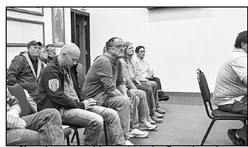How one aspect of “1917” makes it all work


I’ve been playing catch up on some films that I’ve been meaning to see over the past few weeks, which means you get another column about a movie that I just saw! Exciting stuff, I know, but look…it’s February and it’s cold out. I typically reserve my adventures for when it’s over fifty degrees out; I wasn’t built for the Wisconsin winter. Luckily, the Colby Community Library has my back and their current February movie theme has given me the perfect excuse to stay inside and watch movies.
Anyhow, one of the films that I checked off my “to watch” list last week was “1917.” The movie, which came out in 2019 and was directed by Sam Mendez, revolves around the journey of two British soldiers as they try to deliver a message across no man’s land before thousands of their allies fall into a deadly trap. I’m glad that I finally got around to watching it, because “1917” brings something new to the table, an impressive feat for the genre. The entire film, its plot, themes and purpose revolve so much around the way it was shot that it is integral to the tale being told.
Most movies utilize cuts from one shot at one camera angle to another shot from a different camera angle. While “1917” also features cuts, they are, outside of one very obvious one, hidden so that they are difficult to pinpoint. The idea is to create a movie that looks like it was filmed as one continuous shot, which is impressive on multiple fronts.
The first is the technical precision required to pull off such a feat. Using extremely lengthy shots requires the entire crew, to hit their marks perfectly over the entire shot. Typically, you can cut around a bad line or two or a section where the camera loses focus from a take and still use part of a performance, but with such long takes, there is no such leeway. If a mistake is made, the shot is useless and you have to start from the beginning. What makes “1917’s” achievement especially impressive is its scale; there are hundreds of extras involved in some scenes and the camera is constantly moving to keep up with the characters. One in particular towards the end of the film is especially outstanding in this regard, following a furious sprint across a battlefield that serves as climax to both the story and the impressive cinematography and craftsmanship present.
But all of that is in service to what the film is trying to accomplish. “1917” does not have the deepest plot (though it is serviceable) nor the most complicated characters (though they are sympathetic and believable), and if it were shot in a more typical fashion, I would probably not be writing this column.
No part of Lance Corporals Blake and Schofield’s harrowing mission is left out. From the moment they are told to meet with Colin Firth’s General Erinmore to the second their journey ends, we are with them the entire time.
Usually, movies cut out the “in between” stuff, the walking to different locations, conversations that don’t need to be heard, etc., because they are boring. All of that is present in “1917,” but instead of being boring, it is engrossing. Conversations between characters while they walk keep less dangerous environments engaging, while the silent treading through no man’s land or sneaking around ruins maintains momentum through sheer tension. The pacing is probably one of the more impressive aspects of the film as it keeps the audience engaged while also appearing authentic.
And that is the key; trying to give an authentic look at war putting its audience in the shoes of someone there. Our main characters are not special forces agents capable of taking down a battalion of enemy soldiers single-handedly, they are just regular people. The places that they must navigate are full of the devastation wrought by the fighting around them and the moment to moment dangers are on a much smaller scale than the armadas a Marvel superhero deals with on the regular, but feel a thousand times more threatening.
This film is not about wowing you with mind-bending plot twists or sporting the most memorable characters of all time, but rather it’s about creating a mood, a moment in time, a journey. After finishing the movie, I felt like I had gone on the entire nine-mile trudge with our main characters, an effect that is largely created by the way in which it was shot. There are no “in betweens” to be cut because all of it is important. It’s a movie not about the destination but rather the journey and putting you on it. And, in my opinion at least, it was a worthwhile one.
A C ertain Point of V iew




